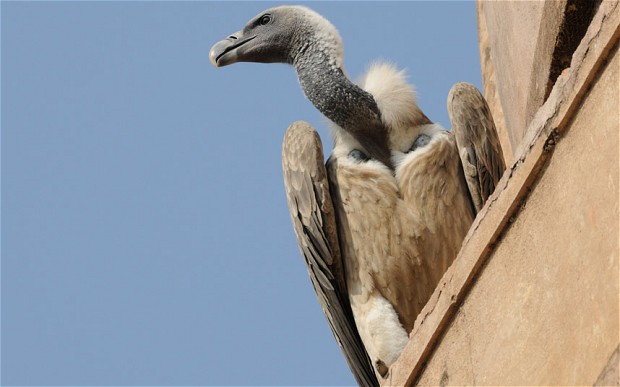Eight critically endangered white-backed vultures that were born and raised in captivity will be released for the first time from a vulture conservatory in Pinjore, Haryana in March next year.
India is home to nine species of vultures: three white-backed, three long-billed and three slender-billed vultures. These vulture species have witnessed a catastrophic dip in population numbers by more than 90 percent since the 1990s, putting them on the International Union for Conservation of Nature (IUCN’s) list of critically endangered species.
The Jatayu Conservation Breeding Centre in Pinjore is the world’s largest facility within the state’s Bir Shikargah Wildlife Sanctuary for the breeding and conservation of Indian vulture species. It is a joint project managed by the Haryana government and Bombay Natural History Society (BNHS).
The project is also supported by the British government’s Darwin Initiative for the Survival of Species Fund to investigate the sharp decline in numbers of these three species of Indian vulture.
Since it first opened its doors in 2001, the conservatory has raised and maintained what has become the world’s largest collection of the three critically endangered ‘Gyps’ species of vulture in a single place.
In a project nearly seventeen years running, the conservatory will be releasing eight birds tagged with a satellite tracking device into the wild. This gives conservationists insight into where and how their populations are. Tracking tags are also extremely useful to study animal behaviour in captive animals that are returned or released into the wild.
Vulture numbers, the world over, have thinned since the 1990s — largely from consuming diclofenac — a drug toxic to vultures but useful to treat cattle infections.
On eating carcasses of cattle that were treated with diclofenac, vultures would die, with symptoms of kidney failure. While the use of diclofenac in cattle was banned in 2006, the vulture populations are in the process of recovering with the help of breeding initiatives like that in Pinjore.
“We are planning to introduce 100 pairs each of the three species of white-backed, long-billed and slender-billed vultures in the wild (over) the next 10 years… before that, findings from the first batch proposed to be released (next year) will be crucial to the future programmes,” Dr Vibha Prakash, BNHS principal scientist.
The toxicity to vultures from ingesting diclofenac appears to have come down significantly, and the numbers of Indian vultures finally recovering.
“If there is no toxicity-related death of these eight birds in two years, then we will go for the release of 20-25 birds each year,” Dr Prakash told IANS.
“It is time to assess whether the provisional Vulture Safe Zone has become a true Vulture Safe Zone, but only the vultures can show us that,” Toby Galligan, senior conservation scientist at RSPB Centre for Conservation Science said in a Birdlife report. “We are using satellite telemetry to track vultures remotely and in the field. If any die, we can recover them, examine them for the cause of death and prevent other vultures dying from that cause.”
The effort in Pinjore is only the second such long-term project to conserve endangered Indian vulture species — the first being a similar project by Birdlife last year for white-rumpled vultures.
The tags will also be very useful in discovering whether the captive-reared birds behave normally in the wild. Since this is the first experiment of its kind, such findings will prove vital in future programs.
Source: FP
Image Courtesy:The Telegram
You may also like
-
New Heat-Based Approach To Cancer Treatment Can Reduce Chemotherapy Doses
-
Scientists Take A Major Step Towards Unification Of Classical & Quantum Gravity
-
India Graphene Engineering and Innovation Centre (IGEIC) Under the Vision of Viksit Bharat@2047 Launched
-
New High-Performance Gas Sensor can Monitor Low Level Nitrogen Oxides Pollution
-
Antidepressant Drug can be Repurposed for Treating Breast Cancer
